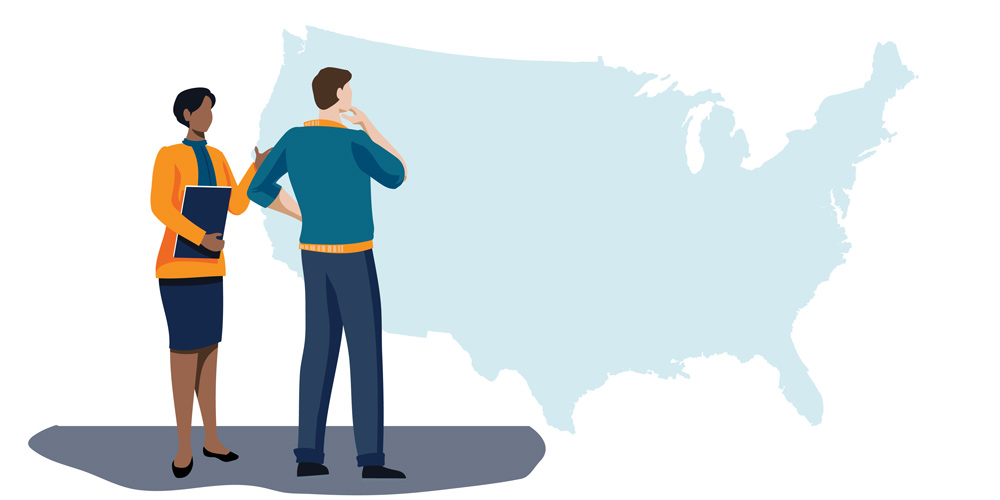
U.S. minimum wage expected to increase in 25 U.S. states in 2024
State minimum wages increased in 2023 in over 20 U.S. states, and there are more increases scheduled for 2024. If you’re wondering, “When does minimum wage go up in my state?” check out our guide below.

Our summary of minimum wage in all states for 2024
The current minimum wage rates will be changing in many states in 2024. Staying up to date on these wage changes can be challenging, especially if your company has locations in multiple states.
To make it easier, we have a detailed breakdown of the new minimum wage rates as reported by the Department of Labor.
Alabama: No state minimum wage law*
Alaska: $10.85
Arizona: $13.85
Arkansas: $11.00
California: $15.50
Colorado: $13.65
Connecticut: $15.00
Delaware: $11.75
Florida: $12.00
Georgia: $5.15 (However, if the employer is subject to the Fair Labor Standards Act, they must pay $7.25 per hour.)
Hawaii: $12.00
Idaho: $7.25
Illinois: $13.00
Indiana: $7.25
Iowa: $7.25
Kansas: $7.25
Kentucky: $7.25
Louisiana: Employers subject to the Fair Labor Standards Act must pay employees $7.25 per hour.
Maine: $13.80
Maryland: $15.00
Massachusetts: $15.00
Michigan: $10.10
Minnesota: Employers with an annual revenue of $500,000 or more must pay a minimum wage of $10.59. If the employer’s annual revenue is less than $500,000 annually, the minimum wage is $8.63.
Missouri: A 2023 increase to $12.00 ($11.15 in 2022)
Mississippi: $7.25
Montana: Employers with gross annual sales of $110,000 or more must pay workers a minimum of $9.95 per hour. However, businesses not covered by the Fair Labor Standards Act with gross annual sales under $110,000 must pay workers a minimum of $4.00 per hour.
Nebraska: $10.50
New Mexico: $12.00 ($11.50 in 2022)
Nevada: If Nevada employers offer qualifying health insurance, their minimum wage is set at $10.25. If they don’t offer health insurance, the wage is $11.25.
New Hampshire: $7.25
New Jersey: $14.00
New York: The minimum wage remains the same in New York for 2023. However, it’s segmented; fast food locations have a minimum wage of $15.00; other businesses, $14.20.
North Carolina: $7.25
North Dakota: $7.25
Ohio: Employers with annual gross receipts of $372,000 or more must offer a minimum of $10.10 per hour. If the annual gross receipts are under $372,000, the minimum rate is $7.25.
Oklahoma: Employers with 10 or more full-time employees at any location or employers with annual gross sales more than $100,000 pay a minimum rate of $7.25. Employers that don’t meet those qualifications must pay workers a minimum of $2.00 per hour.
Oregon: $14.20
Pennsylvania: $7.25
Rhode Island: $13.25
South Carolina: $7.25
South Dakota: $10.80
Tennessee: $7.25
Texas: $7.25
Utah: $7.25
Virginia: $12.00
Vermont: $12.55
Washington: $15.74
Wisconsin: $7.25
West Virginia: $8.75
Wyoming: $5.15
District of Columbia: $17.00
Puerto Rico: $9.50
The difference between federal and state minimum wage
Most U.S. states along with Washington, D.C., have higher minimum wage rates than federal law. Five states — Alabama, Louisiana, Mississippi, South Carolina, and Tennessee — have no state minimum wage. Meanwhile, Georgia and Wyoming have a lower wage rate than the federal minimum wage of $7.25, though Georgia does have some exceptions to this law.
On January 1, 2024, the District of Columbia will have the country’s highest minimum wage at $17.00 per hour. The highest minimum wage state will be the state of Washington at $15.74 per hour, followed by California at $15.50 per hour. The state with the lowest minimum wage is Oklahoma, though its rate is dependent on the employer’s annual gross sales and the number of full-time workers they employ.
Meanwhile, some states have unique wage laws. For example, Minnesota bases their minimum wage on the employer’s revenue, with Ohio and Montana adopting similar policies. In Nevada, the minimum wage is partially determined by whether an employer offers health benefits to its workers.

An overview of today’s minimum wage workers
More than half of the workers in the U.S. work entry-level and minimum wage jobs, according to the Bureau of Labor Statistics.
Workforce outlook: In 2022, the most recent year on record, there were approximately 78.7 million workers paid at hourly rates as opposed to salary exempt or non-exempt roles. One million of these workers earned the federal minimum of $7.25 or below.
Age: Workers under the age of 25 represent under one-fifth of hourly paid workers. However, in 2022, they accounted for 45% of those paid the national minimum wage or less.
Full- and part-time status: About 3% of part-time workers (people who usually work fewer than 35 hours per week) were paid the federal minimum or less, compared with about 1% of full-time workers.
Industry: The industry with the highest percentage of workers earning hourly wages at or below the federal minimum wage in 2022 was leisure and hospitality (about 7%). Three-fifths of all workers paid at or below the federal minimum were employed in this industry, almost entirely in restaurants, bars and other food services. For many of these workers, tips may supplement the hourly wages received.
State of residence: As of 2022, 30 states provide wages higher than the federal minimum of $7.25. However, approximately 3% of workers in the District of Columbia, Mississippi, Louisiana, and Rhode Island still earned wages that matched the federal minimum or were paid below that standard. In states including Arizona, California, New York, Alabama, Connecticut and others, under 1% of hourly workers were paid $7.25 per hour or less.
*All data from the Bureau of Labor Statistics
The impact of minimum wage increases on employers
While several factors come into play, the average wage growth in 2024 will be 3.5%, according to SHRM. This is below the 3.8% to 4.1% range in 2023, with CNBC noting the decrease is due to the continuing inflation concerns.
For many employers, the wage increases won’t significantly impact their 2024 staffing plans because they are already paying above minimum wage standards. However, some employers are reconsidering their pay structure and adding benefits for hourly-wage workers.
Companies with multiple locations also have different options to align workers with the minimum wage in their respective city, county and state. One such option is to match wages in each municipality. However, some employers apply the highest minimum wage from municipalities in which they operate to all locations.
PeopleReady worked with a major national retailer to create a temp-to-hire staffing model including higher wages, improved attendance and increased employee retention.
Ensure success in your 2024 staffing plan with PeopleReady
PeopleReady works with businesses in over 600 communities across North America to support their staffing needs. We serve a variety of industries, including hospitality, events, construction, retail, manufacturing and more. Reach out to us today to learn how we can help your business in 2024.

